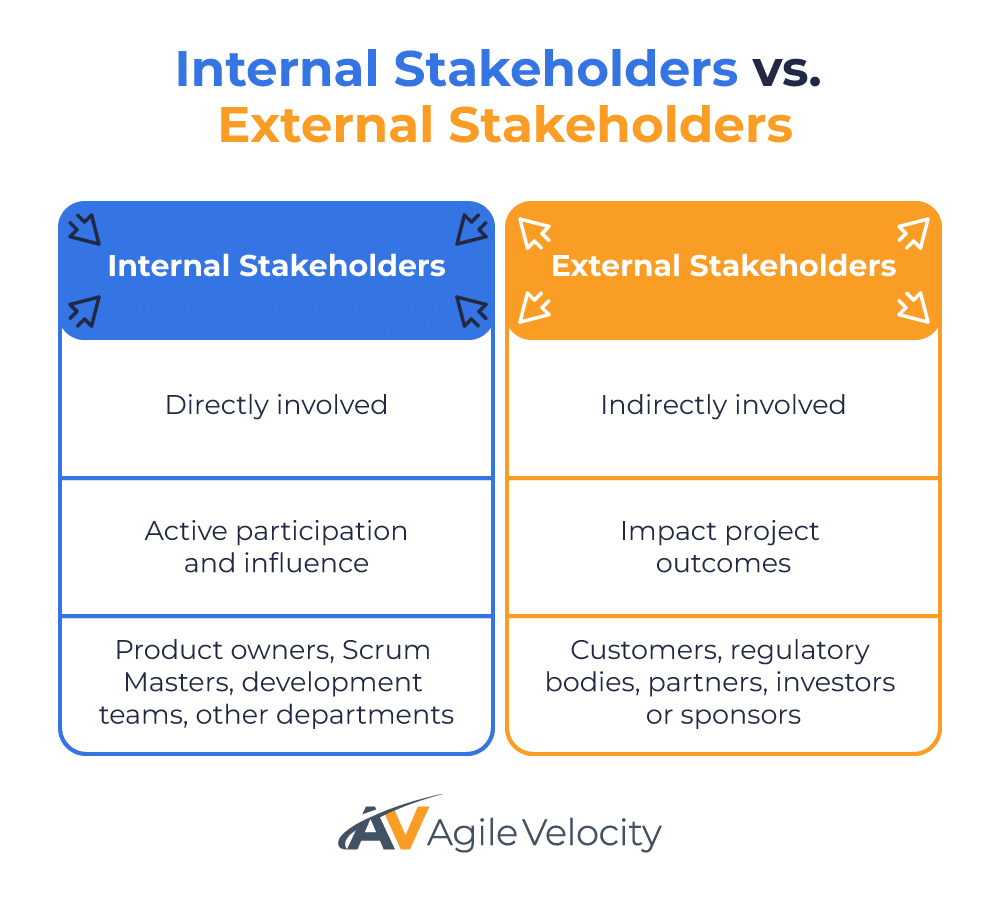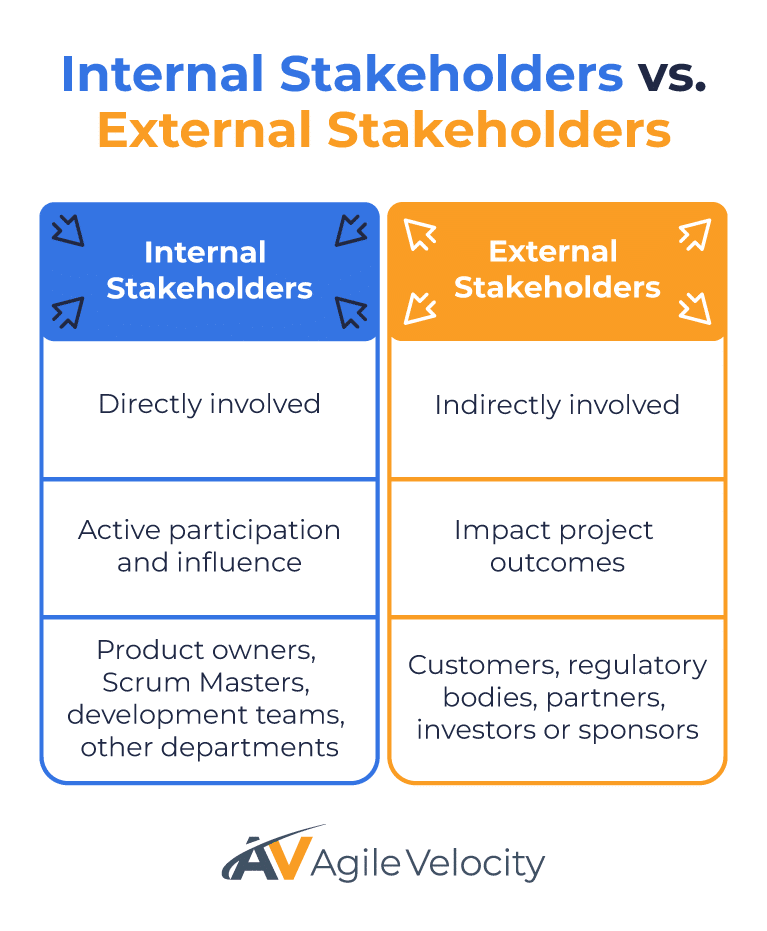Engaging stakeholders effectively in Agile projects is paramount for ensuring project success and alignment with business goals. This article explores powerful strategies to enhance stakeholder engagement, emphasizing the importance of continuous involvement throughout the Agile project lifecycle.
Understanding the Stakeholder Landscape
Effectively managing stakeholder relationships starts with a clear understanding of the stakeholder landscape. Identifying who your stakeholders are and categorizing them is crucial. For Agile projects, stakeholders typically include product owners, development teams, executives, customers, and sometimes regulatory bodies.
- Primary Stakeholders: Directly involved in the project, such as product owners, Scrum Masters, and Scrum Teams.
- Secondary Stakeholders: Impacted by the project outcomes but not involved in day-to-day operations, such as other departments or regulatory bodies.
Understanding Internal vs. External Stakeholders
In Agile projects, the distinction between internal and external stakeholders is essential for customizing engagement and communication strategies. Each group has different concerns, contributions, and communication preferences, impacting Agile project development and execution.


Internal Stakeholders
Internal stakeholders are individuals or groups within the organization who are directly involved in or significantly impacted by the Agile project. Their active participation and influence are crucial for project success.
- Executives: Align the effort strategically, provide resources, and make decisions.
- Product Owners: Act as liaisons between the teams and stakeholders, prioritize backlogs and ensure clarity in the product vision..
- Scrum Masters and Development Teams: Deliver high-quality increments and swiftly adapt to changes.
- Other Departments: Support broader workflows and integration into organizational goals.
External Stakeholders
External stakeholders have an interest in or are impacted by the project outcomes but operate outside the organization. Their influence often guides strategic directions.
- Customers: Their feedback and satisfaction are critical for continuous improvement.
- Regulatory Bodies: Ensure compliance with standards and protect against legal risks.
- Partners and Suppliers: Provide resources or services essential for progress.
- Investors or Sponsors: Have a financial stake in the project towards objectives.
Be the Leader Your Team Needs
Engaging Different Stakeholders
- Communication Style: Tailor communication methods and frequency to suit each stakeholder group. For example, internal stakeholders often participate in regular sprint reviews, while for external stakeholders, periodic updates and formal presentations might be more appropriate.
- Feedback Loops: Establish processes for gathering feedback crucial for both internal teams (through daily stand-ups) and external stakeholders (via surveys or feedback sessions).
- Participation in Agile Events: Encourage relevant internal stakeholders to participate in Agile events and consider involving key external stakeholders when their input can optimize project outcomes.
Understanding the unique roles, interests, and influences of internal and external stakeholders allows for strategic engagement that drives Agile project success.
Mapping Stakeholder Influence and Interest
Creating a stakeholder map helps in understanding the influence and interest of each stakeholder. This mapping allows you to tailor your engagement strategies effectively:
- High Influence, High Interest: Engage closely and keep them satisfied.
- High Influence, Low Interest: Keep them informed to ensure their support.
- Low Influence, High Interest: Keep them updated and consult them regularly.
- Low Influence, Low Interest: Monitor with minimal effort.
Techniques for Effective Engagement
Effective stakeholder engagement is about more than just regular meetings; it’s about ensuring stakeholders are aligned with the project and contributing positively to its success.
In this section, we’ll provide techniques and actionable tips to ensure your stakeholder engagement is both effective and aligned with Agile project goals. Mastering these strategies enhances collaboration and fosters a shared vision among all parties involved.
Implementing Agile Practices

In Agile projects, effective stakeholder engagement is crucial for aligning goals and fostering collaboration. This section outlines several Agile techniques, such as regular sprint reviews and adaptive feedback loops, to ensure active stakeholder participation and alignment with project objectives. By mastering these strategies, your team can enhance communication and collaboration, driving project success.
Regular Feedback Loops
Incorporate consistent updates and feedback opportunities, such as Sprint Reviews and demos, to enable stakeholders to engage actively throughout the project. These feedback loops ensure that stakeholders remain informed about project developments and can provide timely input, which helps in aligning the project with their expectations.
Actionable Tip: Schedule Sprint Reviews at the end of each Sprint and encourage stakeholders to attend these sessions. This direct interaction fosters transparency and allows for immediate feedback on the progress.
Leveraging Technology
Use digital tools like Jira and Zoom to facilitate real-time communication and transparency across teams. These tools support Agile-compatible communication strategies by allowing for quick updates and visual transparency through Kanban boards.
Actionable Tip: Implement a Kanban board to visualize work in progress and use collaboration tools to maintain open lines of communication. This ensures that stakeholders can easily track progress and stay informed about any changes.
Stakeholder Analysis
Conducting stakeholder analysis helps identify influences and motivations, allowing teams to align projects with stakeholder needs more effectively. This proactive management enables teams to anticipate and resolve potential conflicts.
Actionable Tip: Perform a SWOT analysis (Strengths, Weaknesses, Opportunities, Threats) for each key stakeholder to understand their perspectives and how they might impact the project.
Adapting Engagement Methods
Tailor your engagement strategies to individual stakeholder preferences. Whether through workshops, one-on-one conversations, or digital platforms, adapting your methods ensures effective interaction and engagement.
Actionable Tip: Conduct surveys to understand stakeholders’ preferred communication channels and adjust your engagement methods accordingly. Personalized engagement increases stakeholder satisfaction and involvement.
Incorporating Agile practices is crucial for success as it ensures continuous stakeholder engagement, fosters effective collaboration, and keeps projects aligned with the evolving needs of the business. Agile Methodologies like regular feedback loops and adaptive planning allow teams to quickly adapt to changes and deliver high-quality increments, maximizing project value. These practices enhance transparency and communication, key factors in driving successful project outcomes.
Building Strong Relationships

Managing diverse stakeholder expectations can be challenging but is essential for project success. Open communication channels are vital for aligning different stakeholder priorities with Agile principles. Establishing strong relationships with stakeholders is foundational to effective engagement. Trust and mutual respect create a collaborative environment conducive to project success.
Prioritizing Communication
Transparent and frequent communication builds trust and ensures everyone is aligned with the project goals. By establishing clear objectives and expectations, you reduce the risk of conflicts and misunderstandings. Be transparent about project progress, challenges, and changes. Honest communication builds credibility and trust with stakeholders.
Actionable Tip: Develop a communication plan that outlines the frequency, channels, and types of updates for each stakeholder group. Regularly review and adjust this plan based on stakeholder feedback. Share both successes and setbacks in regular updates. Providing a balanced view helps stakeholders appreciate the realities of project management.
Active Listening
Ensure that you actively listen to stakeholder concerns and suggestions. This demonstrates respect and fosters a sense of ownership among stakeholders.
Actionable Tip: During meetings, practice active listening by summarizing key points and asking clarifying questions to ensure understanding.
Encouraging Cross-Functional Teams
Promote the formation of cross-functional teams that include stakeholders from different departments. This diversity fosters innovative solutions and ensures that various perspectives are considered.
Actionable Tip: Organize regular cross-functional team meetings to discuss progress, share insights, and address challenges collaboratively.
Recognizing and Valuing Contributions
Acknowledge the efforts and contributions of stakeholders. Recognition boosts morale and reinforces the importance of their involvement.
Actionable Tip: Implement a recognition program that highlights stakeholder contributions during project milestones or in company communications.
Creating a collaborative culture encourages stakeholders to work together towards common goals, enhancing project outcomes. By prioritizing open and transparent communication, teams can effectively manage expectations and reduce the risk of conflicts, ultimately enhancing stakeholder satisfaction and project success.
Managing Conflicting Interests

In Agile projects, conflicting stakeholder interests can arise. Effectively managing these conflicts ensures that the project remains on track.
Identifying Conflicts Early
Proactively identify potential conflicts by understanding stakeholder interests and priorities.
Actionable Tip: Conduct regular stakeholder interviews to uncover any emerging conflicts and address them promptly.
Facilitating Resolution
Use mediation techniques to resolve conflicts, ensuring that all parties feel heard and respected.
Actionable Tip: Arrange one-on-one meetings with conflicting stakeholders to understand their perspectives and work towards mutually beneficial solutions.
Managing conflicting interests within Agile projects is vital to maintaining a harmonious project trajectory and ensuring effective collaboration among stakeholders. When conflicts are identified and addressed early, it minimizes disruptions and re-aligns diverse stakeholder perspectives towards common project objectives. Utilizing mediation and open communication channels aids in fostering mutual respect, allowing for constructive negotiation and preserving project momentum.
Sustaining Engagement Throughout the Project Lifecycle
Continuous engagement is essential for maintaining stakeholder support and ensuring project success from initiation to completion.
Regular Check-Ins
Schedule regular check-ins with stakeholders to review progress, gather feedback, and adjust strategies as needed.
Actionable Tip: Set up monthly or bi-weekly stakeholder meetings to discuss updates, address concerns, and plan next steps.
Adapting to Changes
Be flexible and adapt engagement strategies to accommodate changes in stakeholder needs or project scope.
Actionable Tip: Use the Path to Agility® Navigator to reassess stakeholder engagement strategies periodically and make necessary adjustments based on project developments.
To sustain engagement throughout the Agile project lifecycle, it is crucial to foster ongoing communication and adaptability in strategies to meet evolving stakeholder needs. By consistently involving stakeholders and addressing their concerns, you ensure a collaborative path to achieving project goals. In the following section, we’ll delve into specific techniques and strategies that further enhance stakeholder engagement and collaboration in Agile projects.
Driving Success through Stakeholder-Centric Agile Practices
Successful stakeholder engagement in Agile projects requires a structured, proactive approach. By implementing these strategies—understanding stakeholder dynamics, prioritizing communication, fostering strong relationships, leveraging tools like Path to Agility Navigator, and sustaining engagement throughout the project lifecycle—Agile teams can improve project transparency and deliver value-driven outcomes. Partner with Agile Velocity today and gain expert support to achieve Organizational Agility.



